Tasty and easy to grow cucumbers “Lukhovitskie”
In the Moscow region there is the city of Lukhovitsy, which residents proudly call the Russian capital of cucumbers. Here they are grown in every yard; many varieties are cultivated in the city. Local climatic conditions are very suitable for the culture.
The official hybrid Lukhovitsky F1 was entered into the State Register in 2006 as independently bred and recommended for breeding in the Northern, Northwestern, Central, and Volga regions of the country.
Description of cucumbers
Lukhovitsky hybrid is parthenocarpic. It is distinguished by early ripening and good yield.
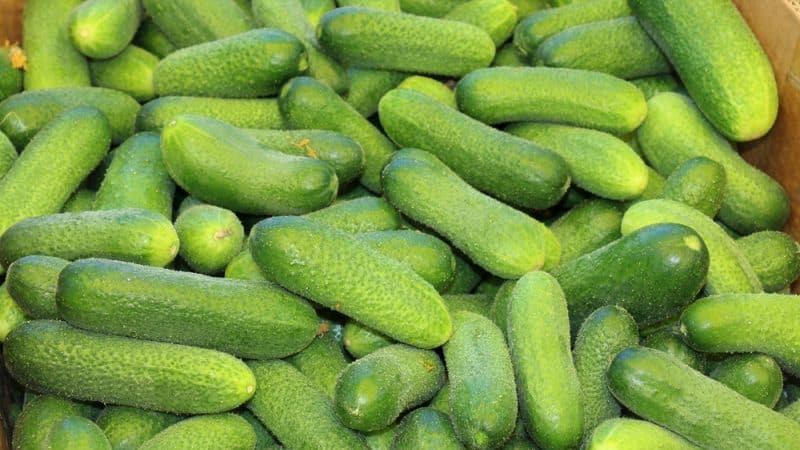
Distinctive features
Features of culture:
- bushes quickly adapt to the cold;
- can grow even in the absence of bright sunny color;
- resistant to many cucumber diseases;
- have only female flowers (do not require pollination).
Cucumbers are suitable for commercial cultivation: they store well and do not change their presentation during transportation.
Composition and properties
Vegetables are tasty and extremely healthy. The calorie content of cucumbers is 15 kcal per 100 g of product. Almost 95% of the composition is water, so the fruits are good at removing toxins from the body and flushing the kidneys.
The product contains vitamins A, B1, B2, C, PP, beta-carotene, valuable minerals: copper, potassium, magnesium, zinc, chromium, sodium, phosphorus, iodine.
Regular consumption of cucumbers prevents the development of atherosclerosis, cleanses blood vessels and dissolves small kidney stones.
Important! Cucumbers are not recommended for people with severe kidney failure.
Characteristics
The shade-tolerant crop does not slow down growth even with ultraviolet deficiency. When growing in greenhouses, no additional installation of special lamps is required. In open ground, even areas with temporary shading are chosen.
Direct sunlight is not harmful to the plant: No burns appear on the leaves, and the fruits do not lose their elasticity.
Bush
The bushes are tall, with a strong central stem. The leaves are medium in size, grow densely, the hair on them is sparse and smallish.
The root system is poorly developed. The penetration depth is no more than 40 cm. The flowers grow in 3 inflorescences and have a characteristic light orange color.
Fruit
Lukhovitsky cucumbers are different: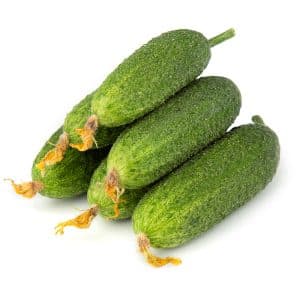
- cylindrical, elongated shape, up to 12 cm long, average weight 90–95 g;
- dark green color, interspersed with elongated light stripes;
- glossy surface without a waxy coating, soft spines and small tubercles on the thin skin, which is not peeled when preparing salads;
- juicy dense pulp without voids;
- small seeds in small quantities;
- sweetish taste, lack of bitterness even without regular watering;
- characteristic subtle aroma;
- high degree of crunch, which remains after cooking or canning.
Productivity
A distinctive feature of the hybrid is its high yield. The abundance of fruiting is practically not affected by weather conditions. Even in cloudy and humid weather, the plants bear fruit. The only thing the crop is poorly resistant to is wind.
In open beds, up to 8 kg of fruits are collected from a bush, in greenhouses - up to 20 kg.
How to grow your own
Cucumbers are cultivated both by seedlings and by direct sowing in the ground.
Planting seeds and seedlings
Direct sowing on the beds is carried out at the end of May. Preparing the soil for this begins in the fall. There is a very original method that significantly increases the yield and germination of seeds. This requires:
- make a trench about 50 cm deep and up to 1.5 m wide;
- put wooden shields on the sides;
- put film on the bottom of the trench;
- sprinkle sawdust and fresh manure on it;
- Cover everything on top with straw and protective material.
In the spring, all that remains is to remove the cover, dig up a bed about the depth of a spade, add urea, a layer of earthen soil and water with hot water. Seeds are planted in holes up to 5 cm deep at a distance of 35–40 cm from each other.
Important! The site is chosen in a place protected from the wind. Directional sunlight is optional.
The seeds are pre-disinfected in a weak solution of potassium permanganate. They increase their resistance to possible cold on the bottom shelf of the refrigerator.
The hybrid is early ripening, so it is better to grow it in seedlings. In this case, sowing is carried out in April. In this case, follow simple rules: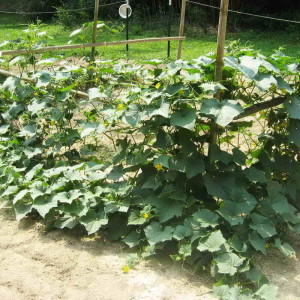
- planted seeds into peat pots without subsequent picking, since the root system of all hybrids is weak and they do not tolerate picking;
- ordinary soil is mixed with leaf humus;
- Before the emergence of shoots, the containers are covered with film material, after which the film is removed and the container is placed in a sunny place;
- The walls of the pots are cut before planting;
- planting in the ground is carried out at the end of May;
- Wire frames are installed over the beds and a film is stretched over them (the structure is removed with the onset of persistent warm weather and as the bushes grow);
- The planting scheme is the same as with the seed method.
Step-by-step cultivation and care
The agricultural technology of the crop is standard, but there are some features:
- the soil should be moist, rich in organic matter;
- at the beginning of the growing season watering moderate, as the fruits ripen - abundant;
- culture regularly feed infusion of mullein or bird droppings;
- the soil is systematically loosened and weeds are removed;
- 2 shoots are left on one stem;
- it is possible to grow the hybrid vertically using supports (the stems of Lukhovitsky cucumbers are strong);
- lower and yellowed leaves are removed.
Features of cultivation and possible difficulties
The main weakness of the Lukhovitsky hybrid is its superficial root system. Therefore, the sprouts are picked and watered carefully. For the same reason, they carefully loosen the ground.
Important! If it is not possible to regularly water cucumbers, it is better to refuse to grow them.
Moisten the bushes only with warm, settled water. Make sure that it does not get on the leaves on sunny days and does not erode the root system.
Diseases and pests
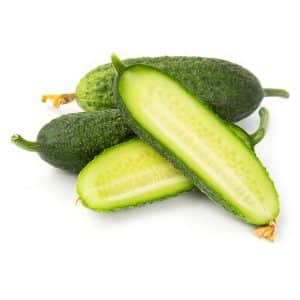
The hybrid is resistant to powdery mildew and cladosporiosis, but can be affected by downy mildew.
To prevent and combat the disease, use:
- Bordeaux mixture;
- "Sulfarid";
- "Fitosporin";
- sulfur products in very low concentrations, as they burn the leaves.
One of the worst pests of cucumbers is the melon aphid. To get rid of the insect, the bushes are sprayed with an ash-soap solution. To prevent spider mites from appearing in dry, hot weather, the humidity in the growing area is increased.
Harvesting and application
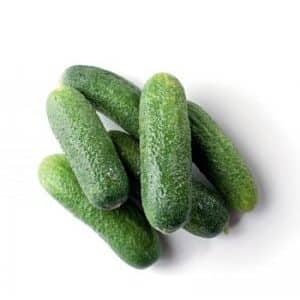
Picking cucumbers daily increases fruiting. Vegetables do not turn yellow or overripe, but it is better to remove them at least every other day.
Thanks to their thin skin, cucumbers are suitable for salads, canning and pickling. Snacks made from slightly undergrown fruits are especially tasty. To do this, they are collected daily.
To keep the harvest longer, cucumbers are cut, leaving a little of the stem. At home, store in the refrigerator in plastic bags. This way they remain fresh for up to a week without losing their presentation.
Advantages and disadvantages
Advantages of a hybrid:
- early ripening (38–40 days after planting);
- self-pollinating;
- possibility of cultivation in almost all regions of the country;
- resistance to major diseases;
- high productivity;
- same size of fruits;
- good transportability while maintaining marketability and taste;
- Suitable for canning, pickling, fresh consumption.
Flaws:
- like all hybrids, Lukhovitsky do not retain their qualities in subsequent generations;
- cucumbers have a relatively weak root system;
- the crop is susceptible to cold winds.
Reviews
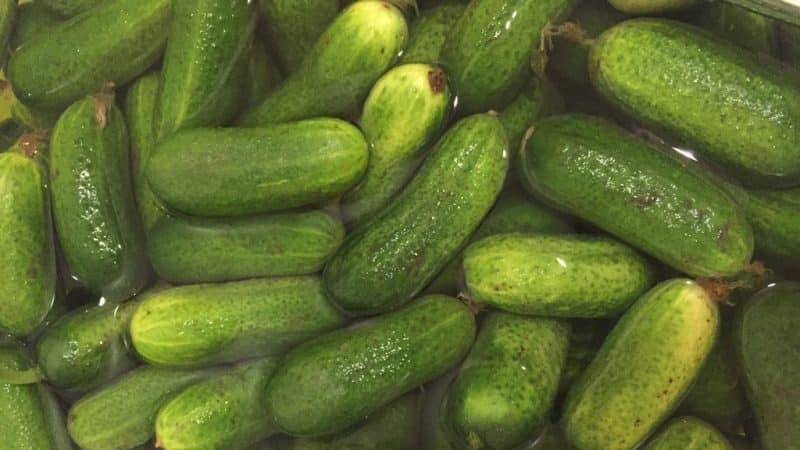
Farmers note the excellent taste of the fruit, presentation and versatility in cooking.
Igor, Voznesensk: “I like the unpretentiousness of the hybrid, its resistance to disease. In fact, only watering and loosening are necessary. I tried growing it vertically and it worked too.”
Anton, Vologda: “The hybrid’s pickled cucumbers are good: crunchy and of the same small shape. When fresh, they have a sweetish taste, but I like them with sourness. However, this is not for everyone. The crop is unpretentious for cultivation, you just need to water it more often.”
Irina, Penza: “I’ve heard a lot about Lukhovitsky cucumbers, seen them in photos, but I’ve only recently grown the hybrid itself. I don’t know how it is in Lukhovitsy, but here cucumbers grow abundantly. Their taste is excellent, truly a benchmark for a cucumber, from my point of view.”
Conclusion
Lukhovitsky cucumbers are a registered brand of vegetables grown in the Lukhovitsky region. The Lukhovitsky f1 hybrid from the Gavrish company is available for cultivation by any farmer.
The crop is early ripening, high-yielding and resistant to major diseases. The sweet taste of the fruit, characteristic crunch and subtle aroma leave no one indifferent.